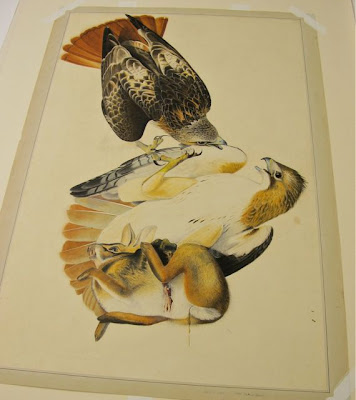Watching Roberta open the big black art boxes was like Christmas morning for me. I think she enjoyed it as much as I did—to be able to show original watercolors to a watercolorist who is also an Audubon freak must be really fun. Ohhhh, the redtails. Fighting over the gory, gooey dying rabbit. Yesss.
Not something a lot of folks would want hanging on their wall, what with the guts and the pee, but oh, my! What a thrill to see it in the original art. It was huge! The redtails and rabbit are life size. Just incredible.
Audubon rendered fur beautifully. I was fascinated with the discernable buildup of paint on the rabbit’s eye. Even more interesting was the way the white undertail coverts of the redtail were shining right through the rabbit’s face. I’m not sure what’s going on here, but it appears that Audubon painted the redtail, then painted the rabbit right over it! You can see the lines of tail feathers on the bunny’s lower lip. I suspect that over time an ingredient in the white paint on the hawk's undertail coverts (zinc? lead?) has oxidized, allowing it to shine through the overpainted rabbit.
Commenter Hap in New Hope MN pointed out what looks like the letter A on the rabbit's mandible. What's with that? I doubt that Audubon would have signed his work with an initial in a dying rabbit's mouth. I think, rather, that it is a perhaps misdrawn tooth that has been made more obvious by the oxidizing white paint--the same bugaboo that lets the hawk's tail feather edges show through the rabbit's jaw. I dug up a photo of a cottontail skull from skullsunlimited.com.
Rabbits don't have teeth on the mandible until you get to the grinding molars. It looks to me like Audubon may have been a bit indecisive about just where the lower incisors would go. I think I see them, properly occluding the upper incisors, but they're not fully rendered. So perhaps that's why he left the "A" just as a pencil outline. And oxidizing paint threw it into relief. But that's just my guess. Other guesses are welcome. A little code letter for engraver Havell? Who can say?
Commenter Hap in New Hope MN pointed out what looks like the letter A on the rabbit's mandible. What's with that? I doubt that Audubon would have signed his work with an initial in a dying rabbit's mouth. I think, rather, that it is a perhaps misdrawn tooth that has been made more obvious by the oxidizing white paint--the same bugaboo that lets the hawk's tail feather edges show through the rabbit's jaw. I dug up a photo of a cottontail skull from skullsunlimited.com.
Rabbits don't have teeth on the mandible until you get to the grinding molars. It looks to me like Audubon may have been a bit indecisive about just where the lower incisors would go. I think I see them, properly occluding the upper incisors, but they're not fully rendered. So perhaps that's why he left the "A" just as a pencil outline. And oxidizing paint threw it into relief. But that's just my guess. Other guesses are welcome. A little code letter for engraver Havell? Who can say?
This is a nasty fight over a big prey item. Beautifully rendered feet and talons, with foreshortening…could the lower bird have pierced the upper bird’s heel pad with its talon? Flowing blood suggests so.
Look at how Audubon merely suggested the fluffy white shank feathers of the redtail with a few pencil lines—shorthand for engraver Robert Havell, who would fill in the blanks as he saw fit.
JJA has a male, top, and a female beneath, and he’s got the size proportions correct—female buteos are as much as 1/3 larger than males. It’s clear to me Audubon had some gorgeous, freshly killed birds to work from—the beautiful flow and lay of the wing feathers say fresh bird to me. I love the shadow of the male hawk’s right wing on his tail. But see those grayish drops on the central tail feathers? Roberta speculated that it could be tea. There is tea on several Audubon originals. They were given to the colorists who hand-colored the elephant folio plates, and while knocking about in the studio, the originals sometimes got things spilled on them. Yikes. I’d hate to be the painter who spilled tea on that translucently lovely tail.
This is one of Audubon's finest birds, I think, lovingly rendered from a freshly killed specimen. Which lives on, two hundred years later. While it's sad that it had to die, that's a high use for a redtail, to be sure.








No comments:
Post a Comment